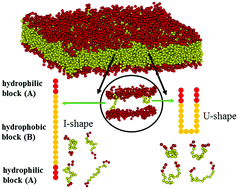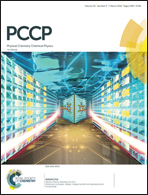Dynamics of bridge–loop transformation in a membrane with mixed monolayer/bilayer structures†
Abstract
Instead of forming a typical bilayer or monolayer membrane, both the bridge (I-shape) and loop (U-shape) conformations coexist in the planar membranes formed by ABA triblock copolymers in a selective solvent. The non-equilibrium and equilibrium relaxation dynamics of polymer conformations are monitored. The non-equilibrium relaxation time depends on the initial composition and increases with an increase in the immiscibility between A and B blocks. The equilibrium composition of the loop-shape polymer is independent of the initial composition and A–B immiscibility. However, the extent of equilibrium composition fluctuations subsides as the A and B blocks become highly incompatible. The influences of the A–B immiscibility on the geometrical, mechanical, and transport properties of the membrane have also been investigated. As the immiscibility increases, the overall membrane thickness and the B block layer thickness (h) increase because of the increment in the molecular packing density. As a result, both the stretching (KA) and bending (KB) moduli grow significantly with the increasing A–B immiscibility. Consistent with the case of typical membranes, the ratio KB/KAh2 = 2 × 10−3 is a constant. Although the lateral diffusivity of polymers is insensitive to immiscibility, the membrane permeability decreases substantially as the A–B immiscibility is increased.



 Please wait while we load your content...
Please wait while we load your content...